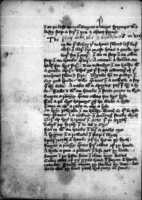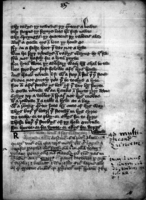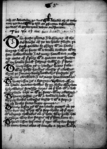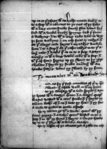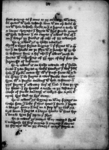|
|
| (14 intermediate revisions by the same user not shown) |
| Line 10: |
Line 10: |
| | | keyimage = File:MS Harley 3542 082r.png | | | keyimage = File:MS Harley 3542 082r.png |
| | <!----------General----------> | | <!----------General----------> |
| − | | Index number = [[WI::—]] | + | | Hagedorn's catalog = — |
| − | | Wierschin's catalog= [[WC::—]]
| + | | Wierschin's catalog = — |
| − | | Hils' catalog = [[HK::—]]
| + | | Hils' catalog = — |
| − | | Beck catalog = [[BC::—]]
| + | | Beck catalog = — |
| | | Also known as = | | | Also known as = |
| | | Type = [[type::Commonplace book]] | | | Type = [[type::Commonplace book]] |
| Line 40: |
Line 40: |
| | <!----------Form and content----------> | | <!----------Form and content----------> |
| | | Material = Paper, with a British Library binding | | | Material = Paper, with a British Library binding |
| − | | Size = 118 [[folia]] (200 mm x 145 mm) | + | | Size = 118 [[folia]] (145 mm × 200 mm) |
| | | Format = | | | Format = |
| | | Condition = | | | Condition = |
| Line 55: |
Line 55: |
| | | {{English translation|http://www.angelfire.com/planet/megalophias/harleymodern.html|1}} | | | {{English translation|http://www.angelfire.com/planet/megalophias/harleymodern.html|1}} |
| | }} | | }} |
| − | | below = [[File:Edition.jpg|link=http://aaoema.com/Two-Hand-Sword-Translation-SECURE.pdf]] | + | | below = |
| | }} | | }} |
| | The '''MS Harley 3542''' is a compilation manuscript containing a [[fencing manual]], created in [[nationality::English|England]] in the early to mid 15th century.<ref name="Brown">{{cite web |url=http://aaoema.com/Two-Hand-Sword-Translation-SECURE.pdf |title=A Transcription of ff. 84-85 of Harleian 3542 (A verse describing the use of the Two hand Sword) |author=Terry Brown |date= |work= |publisher=Anglo-Saxon Books Ltd |accessdate=30 June 2010}}</ref> It currently rests in the holdings of the [[British Library]] in London, United Kingdom.<ref name="BL">"[http://searcharchives.bl.uk/IAMS_VU2:IAMS040-002049374 Explore Archives and Manuscripts]". [[British Library]]. Retrieved 08 August 2016.</ref> The manuscript seems to be three separate works bound together, including two alchemical compendia (ff 1-16, 17-94) and a medical compendium (ff 95-118). The fencing treatise, known as ''Man yt Wol'' ("The Man that Will"), comprises ff 82-85 of the larger manuscript. Along with the [[MS Cotton Titus A xxv|Cotton Titus]] manuscript and the [[Ledall Roll (Additional MS 39564)|Ledall manuscript]], this is one of only three extant treatises on Medieval English martial arts.<ref name="BL"/> | | The '''MS Harley 3542''' is a compilation manuscript containing a [[fencing manual]], created in [[nationality::English|England]] in the early to mid 15th century.<ref name="Brown">{{cite web |url=http://aaoema.com/Two-Hand-Sword-Translation-SECURE.pdf |title=A Transcription of ff. 84-85 of Harleian 3542 (A verse describing the use of the Two hand Sword) |author=Terry Brown |date= |work= |publisher=Anglo-Saxon Books Ltd |accessdate=30 June 2010}}</ref> It currently rests in the holdings of the [[British Library]] in London, United Kingdom.<ref name="BL">"[http://searcharchives.bl.uk/IAMS_VU2:IAMS040-002049374 Explore Archives and Manuscripts]". [[British Library]]. Retrieved 08 August 2016.</ref> The manuscript seems to be three separate works bound together, including two alchemical compendia (ff 1-16, 17-94) and a medical compendium (ff 95-118). The fencing treatise, known as ''Man yt Wol'' ("The Man that Will"), comprises ff 82-85 of the larger manuscript. Along with the [[MS Cotton Titus A xxv|Cotton Titus]] manuscript and the [[Ledall Roll (Additional MS 39564)|Ledall manuscript]], this is one of only three extant treatises on Medieval English martial arts.<ref name="BL"/> |
| Line 151: |
Line 151: |
| | | width = 60em | | | width = 60em |
| | }} | | }} |
| − | {| class="floated treatisecontent" | + | {| class="treatisecontent" |
| | |- | | |- |
| | ! <p>{{rating|C|Draft Modernization}}<br/>by [[Jon Pellett]]</p> | | ! <p>{{rating|C|Draft Modernization}}<br/>by [[Jon Pellett]]</p> |
| Line 280: |
Line 280: |
| | | width = 60em | | | width = 60em |
| | }} | | }} |
| − | {| class="floated treatisecontent" | + | {| class="treatisecontent" |
| | |- | | |- |
| | ! <p>{{rating|B|Completed Modernization}}<br/>by [[Terry Brown]]</p> | | ! <p>{{rating|B|Completed Modernization}}<br/>by [[Terry Brown]]</p> |
| Line 383: |
Line 383: |
| | == Additional Resources == | | == Additional Resources == |
| | | | |
| − | * [[Benjamin "Casper" Bradak|Bradak, Benjamin "Casper"]] and Heslop, Brandon. ''Lessons on the English Longsword''. Boulder, CO: [[Paladin Press]], 2010. ISBN 978-1-58160-734-5
| + | {{bibliography}} |
| − | * [[Alfred Hutton|Hutton, Alfred]]. {{Google books|E_nSjQIszvEC|The Sword Through the Centuries}}. Dover Publications, 2002. ISBN 978-0486425207
| |
| | | | |
| | == References == | | == References == |
| | | | |
| − | {{reflist|2}} | + | {{reflist}} |
| | | | |
| | == Copyright and License Summary == | | == Copyright and License Summary == |
| Line 395: |
Line 394: |
| | | | |
| | <section begin="sourcebox"/>{{sourcebox header}} | | <section begin="sourcebox"/>{{sourcebox header}} |
| | + | {{sourcebox |
| | + | | work = Images |
| | + | | authors = |
| | + | | source link = |
| | + | | source title= |
| | + | | license = copyrighted |
| | + | }} |
| | {{sourcebox | | {{sourcebox |
| | | work = Modernization (82r - 84r) | | | work = Modernization (82r - 84r) |
| − | | authors = [[Jon Pellett]] | + | | authors = [[translator::Jon Pellett]] |
| | | source link = http://www.angelfire.com/planet/megalophias/harleymodern.html | | | source link = http://www.angelfire.com/planet/megalophias/harleymodern.html |
| | | source title= MEGALOPHIAS His Page | | | source title= MEGALOPHIAS His Page |
| Line 404: |
Line 410: |
| | {{sourcebox | | {{sourcebox |
| | | work = Modernization (84v - 85v) | | | work = Modernization (84v - 85v) |
| − | | authors = [[Terry Brown]] | + | | authors = [[translator::Terry Brown]] |
| | | source link = http://aaoema.com/Two-Hand-Sword-Translation-SECURE.pdf | | | source link = http://aaoema.com/Two-Hand-Sword-Translation-SECURE.pdf |
| | | source title= American Academy of English Martial Arts | | | source title= American Academy of English Martial Arts |
| Line 411: |
Line 417: |
| | {{sourcebox | | {{sourcebox |
| | | work = Transcription | | | work = Transcription |
| − | | authors = [[Alfred Hutton]], [[Terry Brown]] | + | | authors = [[transcriber::Alfred Hutton]], [[transcriber::Terry Brown]] |
| | | source link = | | | source link = |
| | | source title= [[Index:Man yt Wol (MS Harley 3542)]] | | | source title= [[Index:Man yt Wol (MS Harley 3542)]] |
| Line 427: |
Line 433: |
| | [[Category:Digital Scanning]] | | [[Category:Digital Scanning]] |
| | | | |
| | + | [[Category:Esoterica]] |
| | [[Category:Longsword]] | | [[Category:Longsword]] |
| | | | |
| | [[Category:New format]] | | [[Category:New format]] |
| Man yt Wol |
|---|
MS Harley 3542, British Library
London, United Kingdom |
|
|
|
| Type |
Commonplace book |
|---|
| Date |
ca. 1440 |
|---|
| Place of origin |
British Empire |
|---|
| Language(s) |
|
|---|
| Author(s) |
- Unknown (fencing manual)
- Roger de Baron
John Dastin
- Roger Frugard
- Ralph Hoby
- Ramon Llull
- Johannes Pauper
- John Sawtry
- Guillelmus Sedacerius
|
|---|
| Material |
Paper, with a British Library binding |
|---|
| Size |
118 folia (145 mm × 200 mm) |
|---|
| External data |
Library catalog entry |
|---|
| Other translations |
|
|---|
The MS Harley 3542 is a compilation manuscript containing a fencing manual, created in England in the early to mid 15th century.[1] It currently rests in the holdings of the British Library in London, United Kingdom.[2] The manuscript seems to be three separate works bound together, including two alchemical compendia (ff 1-16, 17-94) and a medical compendium (ff 95-118). The fencing treatise, known as Man yt Wol ("The Man that Will"), comprises ff 82-85 of the larger manuscript. Along with the Cotton Titus manuscript and the Ledall manuscript, this is one of only three extant treatises on Medieval English martial arts.[2]
Provenance
The known provenance of the MS Harley 3542 is:[2]
- 1500s - owned and annotated by Thomas Byard, vicar of Bockerill [Devon].
- 1600s - owned by Samuel Knott (d. 1687), rector of Combe Raleigh and priest of Broad Hembury, co. Devon.
- 1600s-early 1700s - owned by Robert Burscough (1650/51-1709), prebendary of Exeter in 1701, archdeacon of Barnstaple in 1703, rector of Cheriton Bishop in 1705.
- 17 May 1715 - acquired by Robert Harley (1661-1724), 1st earl of Oxford and Mortimer, politician.
- 1724-1741 - owned by Edward Harley (1689-1741), 2nd earl of Oxford and Mortimer.
- 1741-1753 - owned by his widow, Henrietta née Cavendish Holles (1694-1755) and her daughter Margaret Cavendish Bentinck (1715-1785), duchess of Portland.
- 1753 - sold for a fraction of their value to the British Museum (at the time of its founding).
- 1973 - moved to the British Library (at the time of its founding).
Contents
This is the table of contents provided by the museum.[2]
| 1r - 14r
|
Treatise on alchemy (The Mirror of Lights)
|
| 14r - 15v
|
Four alchemical recipes
|
| 16rv
|
Three Alchemical recipes (Modus Maurandi)
|
| 17r - 25v
|
Alchemical text (Semita recta Alkymie Alberti)
|
| 25v - 28r
|
Alchemical text on the transmutation of metals ('Per artificium vero fit & transmutacio me/tallorum)
|
| 28v - 35v
|
Alchemical text attributed to Ramon Llull (Verbum albrematum verissimum & approbatum de occultis)
|
| 40r - 41v
|
Alchemical text (Compo[si]cionis / lapidum philosophorum .4. modis)
|
| 41v - 44r
|
Alchemical recipes
|
| 44v - 55v
|
Epistola boni viri, possibly Guillelmus Sedacerius, De alchimie perfectum
|
| 55v - 57v
|
Alchemical text and recipes (Casus magnorum lapsus gravis anteriorum / Sunt afflictorum solamina philosophorum)
|
| 57v - 59v
|
Breviloquium lapis philosophorum by Johannes Pauper
|
| 59v - 60v
|
Alchemical recipe (Opus mirabile)
|
| 60v - 64v
|
Alchemical treatise by John Dastin
|
| 64v - 67v
|
Alchemical text
|
| 68v - 80v
|
De occulta philosophia by John Sawtry
|
| 80v - 81r
|
Alchemical verses
|
| 81r - 82r
|
Alchemical verses
|
| 82r - 84v
|
Draft Modernization 
by Jon Pellett
|
Transcription
by Alfred Hutton
|
The Use of the Two-handed Sword
The first playing and beginning of the substance of the two-handed sword / the first ground begins with an hauke bearing in with the foot with a double round with 3 feet outward and as many homeward making end of the play with a quarter cross smitten with an hauke snatch setting down by the foot.
|
[82r] The Use of the Two-hand Sworde
The ferste pleyng & begÿnyng of the substansce of ye too honde swerde / ye ferst gronde be gynyth w an hauke beryng inwt ye foote wt a double rownde wt. iij . fete howtewarde & as meny homward makyng ende of ye play wt a quarter cros smetyn wt an hauke snach settyng down by ye foote.
|
The 2nd lesson is 2 haukes with 2 half haukes cleaving the elbows with the same 2 double rounds aforesaid with 3 foot outward and as many homeward.
|
The .ij. lesson ys .ij. haukys wt ij. halfe haukys cleuÿg ye elbowys wyth ye same .ij. doublylrowndys forsayde wt .iij. foote owtward . & as meny hamward.
|
The 3rd lesson is a spring upward . with an hauke quarter . down by the cheek . with 3 double rounds standing borne on the head . with a double round born in with the foot . with . 3 outwards.
|
The .iij. lesson ys a sprynge vpward . wt an hauke quarter . downe by ye cheke . wt iij. doubylrowndys stondÿg borne on ye hed . wt a dowbylrownde born in wt ye foote . wt .ij. outwards.
|
The 4th lesson is with a double hauke with 2 double rounds bearing in with a step upon both feet.
|
The .iiij. lesson . ys wt a dowbil hauke wyth .ij. doubil rowndis berÿg inwt a step vp on bothe feete.
|
The 5th lesson is with an hauke meant over the head . but bear it up with a step . break off the earth with running rounds on the head with 2 half haukes borne with 2 cock steps of the foot.
|
The .5. lesson ys wt an hauke menyd our ye hede . but bere ht vp wt a step . breke of ye erthe wt rënyng rowndis on ye hede wt .ij. halfe havkis born wt .ij. koc stappis of ye foete.
|
The 6th lesson bear out the earth with 3 cock steps and so come home out of danger again.
|
The .6. lesson bere ovte ye erthe wt .iij. koc stapps & so come home ovte of danger a gayne.
|
The 7th lesson is . Smite an hauke cross . cross over the elbows with a back step and so smite it on the feet.
|
[82v] [T]he .7. lesson ys . Smyte an hauke cros . cros our ye elbovys wt a bak stop & so smyte ht on ye fet.
|
The 8th lesson is with an hauke cross smitten with a back step borne with both feet and a contrary hauke homeward borne with 2 steps.
|
[T]he .8. lesson ys wt. an hauke cros smytÿ wt a bakstep born wt bothe fete & a contrary hauke hamward born wt.ij. steppis.
|
These be stroke and rule of the two-handed sword to make his hand and his foot accord.
|
[T]hese ben stroke & revle of ye .ij. hondswerd to make hys hond & ys foete a corde.
|
The play of the two-handed sword between 2 bucklers is . first take a sign Of the ground there the play between 2 bucklers . make first a sign to them[3] with a large hauke down to the ground . with . 3 rolling strokes . with an hauke to the other side.
|
[T]he pley of ye .ij. hondswerd by twene .ij. bokelers ys . fyrst take a sygne Of ye gonde ther ye pley by twene .ij. bokelers . make ferst a sygne to hë wt a large hauke down to ye grownde . wt .iij. rollyng strokis . wt an hauke to ye oder side.
|
The 2nd lesson is a chase . or an hauke with a quarter borne in with a cock step and an hauke borne in with a chase foin . that made up with a light spring.
|
[T]he .ij. lesson ys a chase . or an hauke wyt a quartr born in wt a kocstep & an hauke born in wt a chase foyn . y made vp wt a lygte sprÿg.
|
The 3rd lesson is . a chase . with 2 haukes cleaving the elbows.
|
[T]he .3. lesson ys . a chase . vt .ij. havkys cleuyng ye elbovis.
|
The 4th lesson . is a chase smitten with 2 half rounds . with 2 cock steps . a quarter with a step an hauke with a chase foin . with the stroke aventure smitten on 3 feet . and made up with a rake down. ~ borne up with a double hauke . and so serve the stroke aventure upon both feet.
|
[T]he .4. lesson . ys a chase smetÿ wt .ij. half rowndis . wt .ij. kocstoppis . a qrter wt a steppe an hauke wt a chase foyn . wt ye stroke a venture smetÿ on .iij. fete . & made vp wt a rake down . ~ bore vp wt a dovbil hauke . & so serue ye stroke aüetur vp on bothe fete.
|
The 5th lesson . is a chase with an hauke & with a back step standing on the foot . & playing on that other side a quarter and the same chase . and an hauke with a step . and an hauke with a chase foin contrary smitten . and so smite in with both feet i made up with 2 half haukes . with 2 back steps . and with the running.
|
[T]he .5. lesson . ys a chase wt an hauke & wt a bakstep stondÿg on ye foote . & playng on yt othr syde a qrter & ye same chase . & an hauk wt a step . & an hauke wt a chase foyn contry smy// [83r] ten . & so smyte in wt bothe feete i made vp wt .ij. halfe hauke . wt .ij. bakstoppis . & wt ye rënyng.
|
The 6th lesson is . 2 hauke quarters rounds with a broken half hauke a laying down to the foot with a contrary hand this is the first laying a down.
|
[T]he .6. lesson ys .ij. hauke qrters rovnys wt a brokyn halfe hauke a leyng dovn to ye foete wt a contrary honde ys is ye fyrst leyng a dovne.
|
The 7th lesson and the first taking up is 3 rakes upward and 3 downward . and going in with a great step . with double quarter well smitten . bearing out with the foot a broken half hauke setting down the sword by the foot.
|
[T]he .7. lesson & ye fyrst takyng vp ys .iij. rakys vpward & .iij. dovneward . & gan inwt a grete steppe . wt doubyl qrter wel smytÿ . berÿg ovte wt ye foete a brokyn halfe hauke settÿg downe ye swerde by ye foete.
|
The 8th lesson and the second laying a down of thy sword . 2 haukes with a quarter and 3 with the foot with a broken hauke . a laying down to the foot with a contrary hand.
|
[T]he .8. lesson & ye secnde leÿg a dovne of thy swerde .ij. haukys wt a qrter & iii wt ye foete wt a brokyn hauke . a leÿg dovne to ye foete wt a cötrary honde.
|
The 9th lesson and the second taking up of thy sword is 3 haukes on each side standing on the earth still with a stop bor meant on the earth . with an hauke quarter borne with a step . and with a double quarter hand and foot borne over the head . an hauke meant setting down thy sword by thy foot.
|
[T]he .9. lesson & ye secnde takÿg vp of thy swerde ys .iij. haukys on euych syde stondyng on ye erthe stil wt a stop bor menyd on ye erthe. wt an hauke quartr born wt a step . and wt a doubyl qrter honde & foete born our ye hede . an hauke menyd settyng thy swerd by thy foete.
|
The 10th lesson and the 3rd laying down of thy sword is a quarter and in with the foot and an hauke broken at the cheek and then a double hauke about the head broken . and then in with a spring of the foot . with a stroke aventure . with a quarter and with a snatch . laying to the earth with a contrary hand.
|
[T]he .10. lesson & ye .iij. Ieyng dovne of thy swerd ys a qrter & in wt ye foete & an hauke brokÿg at ye cheke & then a doubil hauke a bovte ye hed brokyn . & then in wt a sprÿge of ye foete . wt a stroke auëture . wt a qrter & wt a snache . leyng to ye erthe wt a cötrary hond.
|
The 11th lesson and the 3rd taking up is with a spring with that on hand right up on to the face[4] with an half round broken into a step with a reverence[5] to the cross of thy hilt with a long quarter stroke smitten flat down by the back . with a double broken spring back the foot a drawing . and in with a long rake double . in with the foot walking and on each foot 2 rakes and at the walk's[6] end smite in 4 rakes double born into a step . and so the other rakes in to the walk[7] end . and double that[8] one into a step . again turning in with a long double rake with a step . & with that other hand spring up thy sword to thy right shoulder and smite thy stroke aventure with an hauke setting down thy sword by thy foot.
|
[T]he .11. lesson & ye iij. takÿg vp ys wt a sprynge wt yt on hond rigte [83v] vp on to ye visage wt an halfe rounde broky in to a step wt a reuence to ye cros of thy hilte wt a long cartar stroke smety flat dovne by ye bak . wt a doubil brokÿ spryng bak ye foete a drawyng . & in wt a long rake dobil . in wyth ye foete walkyng & on eche foete .ij. rakys . & at ye alurys ende smyte in .iiij. rakys doubille born into a step . & so ye other rakys in to ye alure ende . & dovbil yt on in to a step . a gayn turnÿg in wt a long dovbil rake wt a step . & wt yt othr hond spryng vp thy swerd to thy rygt shulder & smyte thy stroke auëtur wt an hauke settÿg dovne thy swerd by thy foete.
|
To Encounter with the Two-handed Sword
And as for the first countenance of the two-handed sword . thou shalt walk in with 3 foot to thy adversary with a bold spirit and a merry heart with a single quarter . and a single quarter wasted with a quarter stroke and thus smite thy counter both off and on and let thy hand and thy foot accord together in good offence.
|
To Incounter wth the Two Hand Sworde
And as for ye first contenance of ye .ij. höd swerd . thou shalt walk in wt .iij. foete to thy adursary wt a bold spyrte & a mery herte wt a sengyl qrter . & a sengil quartr wastyd wt a cartr stroke and thus smyte thy conter bothe of & on & lete thy hond & thy foet a corde to geder in goede afense.
|
The 2nd counter is with a double quarter with the foot going . & . a double quarter wasted into a step & in with thy foot & smite a large hauke up into the sky . with a double snatch.
|
[T]he .ij. conter ys wt a doubil quartr wt thy foete goyng . & a dobyl quartr wastid in to a step & in wt thy foete & smyte a large hauke vp in to ye skye . wt a doubil snache.
|
The 3rd lesson of the counter is . a rake on each foot going till thou come to thy adversary . with a double quarter with whole defence borne with another double quarter with whole defence break in & a sign a touch with a large spring & smite with fierce stroke meant with whole defence & so smite this counter both off & on . & bovre thy strokes of each of thy counters.
|
[T]he .3. lesson of ye countr ys . a rake on eche [84r] foete goyng till thou come to thy adusary . wt a doubil quartr wt hole defence born wt an othr dobil qrter wt hole defence breke in & a sygne a toche wt a large sprynge & smyte wt fers stroke menyd wt hole defence & so smyte ys cowntr bothe of & on . & bovrel thy strokis of eche of thy cowntris.
|
The 4th counter is 2 half rounds. With a turn foin . bearing in the foin with a quarter. & an hauke at the sky with a snatch with thy whole defence born before thee[9] . & this counter must be smote with transposing of thy earth of both feet for sureness of defence.
|
[T]he .4. cowntr ys .ij. halfe roundys. Wyth a tnye foyne . beryng in ye foyne wt a qrter . & an hauke at ye skye wt a snache wt thy hole defence born a for the . & ths cowntr most be smete wt tnsposyng of thy erthe of bothe fete for surenesse of defence.
|
The 5th counter is an half round of the second foot . & then smite 2 double haukes & both sides whole . & broken enter in[10] with the first foot, with a double quarter . & so smite a quarter stroke but turn him with a stroke aventure with whole defence . & smite this counter both off and on . & let thy eye, thy foot, & thy hand accord in thy defence . the cause of stroke aventure is called . for a man turns his back on his enemy.
|
[T]he .5. cowntr is an halfe rownde of ye secnde foete . & than smyte .ij. dobil haukys & bothe sides hole . & brokë enter hÿ wt ye ferst foete . wt a dobil qrter . & so smyte a cartr stroke but tne hym wt a stroke auëture wt hole defence . & thvs smyte ths cownter bothe of & on . & lete thy eye . thy foete . & thy honde a corde in thy defence ye cause of stroke auëture is callyd . for a ma tnyth hys bak to hys enmy.
|
The 6th counter is bearing in with 3 foins on both feet . & look thou turn hand & foot & smite a large quarter . & bear in a step with thy back naked borne . & smite a large hauke with fierce heart & draw him strongly up to the sky.
|
[T] he .6. cowntr ys beryng in wt .iij. foynys on bothe fete . & loke thou t¨ne hond & foete & smyte a large qrter . & ber in a stop wt thy bak nakyd born . & smyte a large hauke wt fers hert & draw hym sor vp to ye skye.
|
The 7th counter is meant 3 meant foins & transpose them both going & coming . & smite thy foins with in thy single quarter . & at the last quarter smite a large spring with a lusty step forward & then a chase foin.
|
[T]he .7. cowntr ys menyd .iij. menyd foyns & träspose hä bothe goyng & comyng. & smyte thy foynys wt in thy sengyl quartr . [84v] & at ye last quartr smyte a large sprynge wt a lusty stop a fore & then a chace foyne.
|
|
| 84v - 85r
|
Completed Modernization 
by Terry Brown
|
Transcription
by Terry Brown
|
[1]
[5]
[10]
[15]
[20]
[25]
[30]
[35]
[40]
[45]
|
The Play with the Two-Handed Sword in Verse
man that will to the two hand sword learn both close & clear,
he must have a good eye both far & near.
& an in step & an out step & a quarter strike
A cantel/cautel, a double, an half for his companions.
Two rounds and an half with a good cheer
This is the first counter of the two hand sword sere
Bind them together & say godspeed
Two quarters and a round a step thou him bid
A rake with a spring where thou him abide
Fall in with a strike & stride not too wide
Smite a running quarter out for his side
Fall upon his harness if he will abide
Come in with a rake in every a side
A whole round and an half danger so it betide
4 quarters and a round and a ventures stroke with
Bere up his harness and get thou the grith
Double up lithely and do as I say
Fall in with a strike & bear a good eye
A spring & a round & step in with
spare not a strike if he lie in thy kith
smite a running quarter sore out of thy hand[s]
Abide upon a pendent and lose not thy land
Smite in the left foot & cleave right down
Gather out of thy right hand & smite a strike round
fiercely smite thy strokes together
and hold well thy land that it may be seen
thy rakes, thy rounds, thy quarters about
thy steps, thy foins, let them fast rout
thy springs, thy quarters, thy rebats also
Bear a good eye & let thy hand go
fie on a false heart that dare not abide
When he sees rounds & rakes running by his side
Flee not hastily for little pride
For little Knows thy adversary What him shall betide
let strokes fast follow after his hands
And strike round with a step & still that thou stand
Grieve not greatly though thou be touched a light
For an after stroke is better if thou dare him smite
A good round with a strike & smite right right down
Gather up a doublet & spare not his crown
With a round & a rake abide at a bay
With a running quarter set him out of his way
These are the letters that stand in his sight
To teach, or to play, or else for to fight
These are the strokes of your whole ground
For hurt, or for blow, or else for death's wound
|
|
[84v] The play with the 2-hand sword in verse
man þt wol to þe tohond swerd lern boþe close & cler/
he most have a goede eye boþe fer & ner//
& an in stop · & an owte stop · & an hauke qūrter ∪
A cantel · a doblet . an half for hys fer//
Too rowndys · & an halfe wt a goode chere
This ys þe ferste cownter of þe toohond swerd sere//
Bynde hē to gedere & say god spede ✔
two q˜rters & a rownde a stap þu hŷ bede//
a rake wt a spryng þer þu hŷ a by de ~
ffalle ī wt an hauke & stride noʒte to wyde/
Smyte a rēny̆g qūrter owte for hys syde
Fal a pon hys harneys yf he wole a byde
com in wt a rake in euey a syde
An hole rownde & an halfe • Wath so ht be tyde
·iiij· qūrters & a rownd · & auēturs stroke wyth
Bere up hys harnes & gete þu þe gryth
dobyl vp lyʒthy & do as y seye
ffal in wt an hauke & bere a goede eye
A spryng & a rownde & stap ī wyth
spar noʒth ā hauke yf he lye in þy kyth
smyte a rēny̆g qūrter sore owte of þy honde
A byde a pon a pēdent & lese not þy londe
Smyte ī þe lyfte foete & cleue ryʒt doune
Geder oute of þy ryʒte hond & smyte ā hauke rounde//
ffresly smyte þy strokis by dene ~
and hold wel þy lond þath hyt may be sene
[85r] thy rakys · þy rowndis · þy qūrters abowte
thy stoppis · þy foynys · lete hē fast rowte
thy spryngys · þy quarters · þy rabetis also
Bere a goede eye & lete þy hond go
ffy on a false hert þt dar not a byde
Wen he seyþ rovndys · & rakys rēnyng by hs side
ffle not hastly for a lytil pryde
ffor lytil Wote þy adusary Wath hy̆ shal betide
lete strokys fast folowe aftr hys honde
And hauk rovnde wt a stop & stil þt þu stond
Greve not gretly þov þu be tochyd a lyte
ffor ā aftr stroke ys betr yf þu dar hy̆ smyte
A gode rovnde wt an hauke & smyte ryʒt dovne
Gedyr vp a doblet & spare not hys crovne
Wt a rownde & a rake a byde at a bay
Wt a rēnŷg qūrter sette hŷ oute of hys way
Thys buþe þ e lettrs þt stondŷ in hys syʒte
To Teche · or to play · or ellys for to fyʒte
These buþe þe strokys of þy hole grovnde
ffor hurte · or for dynte · or ellys for deþys wonde
|
|
| 85r - 94v
|
Recipes for medical and alchemical processes
|
| 95r
|
Collection of texts on pulse in Middle English, followed by verse on pulse and humors in Latin
|
| 95v - 97r
|
Gualterius, De pulsibus
|
| 97v - 100v
|
Text on women's medicine (De ornatu mulierum)
|
| 101r - 102r
|
Treatise on medical herbs (Materia medica)
|
| 103r - 110r
|
Astronomical-medical treatise by Ralph Hoby
|
| 110r
|
Eight-line poem on pulses
|
| 110v - 111r
|
Notes on urine (De urinis tractatus)
|
| 111rv
|
Notes on urine (Omnis urina est colamentum sanguinis)
|
| 111v - 112r
|
Text on phlebotomy
|
| 112r
|
Three paragraphs on astrological reckoning for bloodletting
|
| 112v
|
Pen drawing of bloodletting man, with text on veins, but veins not marked
|
| 113r - 115v, 116v
|
Excerpts of Rogerina minor by Roger de Baron
|
| 115v - 116v
|
Excerpts from Summa parva (?) by Roger Frugard
|
| 116v
|
Tables on latitudes of seven climates, all with Greek names
|
| 117r - 118v
|
Pseudo-Nennius, De mirabilibus Britannie maioris
|
| 118v
|
De mensuris
|
Gallery
Additional Resources
The following is a list of publications containing scans, transcriptions, and translations relevant to this article, as well as published peer-reviewed research.
- Bradak, Benjamin 'Casper'; Brandon Heslop (2010). Lessons on the English Longsword. Boulder: Paladin Press. ISBN 978-1-58160-734-5.
- Gaite, Pierre (2018). "Exercises in Arms: the Physical and Mental Combat Training of Men-at-Arms in the Fourteenth and Fifteenth Centuries." Journal of Medieval Military History XVI. Ed. by Kelly DeVries; John France; Clifford J. Rogers. Woodbridge: Boydell Press. ISBN 9781783273102.
- Geldof, Mark Ryan (2011). Þe Herte Þe Fote Þe Eye to Accorde: Procedural Writing and Three Middle English Manuscripts of Martial Instruction [Unpublished MA dissertation]. University of Saskatchewan. http://hdl.handle.net/10388/etd-2011-08-77
- Hester, James (2006). 'The Vse of the Two Hand Sworde': The English Fight Manual of MS Harley 3542 (A Critical Edition) [Unpublished thesis]. University of York.
- Hester, James (2009). "Real Men Read Poetry: Instructional Verse in 14th-century Fight Manuals." Arms & Armour 6(2): 175-183. doi:10.1179/174962609X417590.
- Hester, James (2014). "The Terminology of Medieval English Fight Texts: A Brief Overview." Can These Bones Come to Life? Insights from Reconstruction, Reenactment, and Re-creation 1: 70-78. Wheaton: Freelance Academy Press. ISBN 978-1-937439-13-2.
- Hutton, Alfred (2002). The Sword Through the Centuries. Dover Publications. ISBN 978-0486425207.
- Voigts, Linda Ehrsam (2008). "Wolfenbüttel HAB Cod. Guelf. 51. 9. Aug. 4º and BL, Harley MS. 3542: Complementary Witnesses to Ralph Hoby's 1437 Treatise on Astronomical Medicine." Electronic British Library Journal 2008. doi:10.23636/952.
References
Copyright and License Summary
For further information, including transcription and translation notes, see the discussion page.

